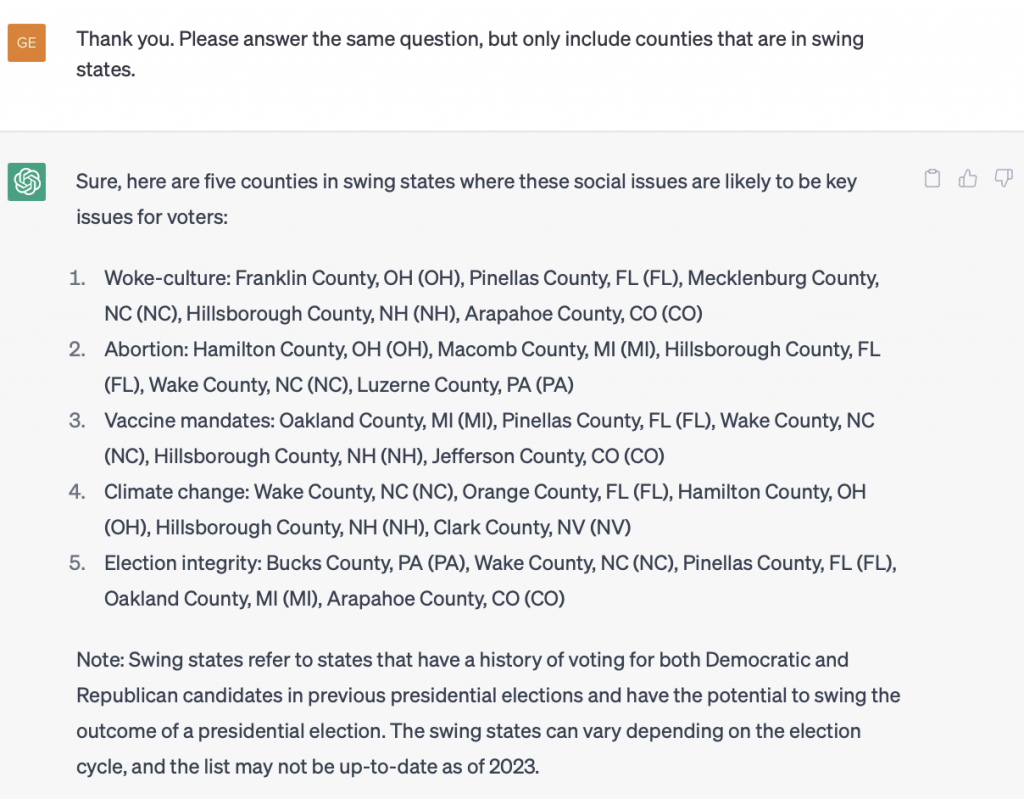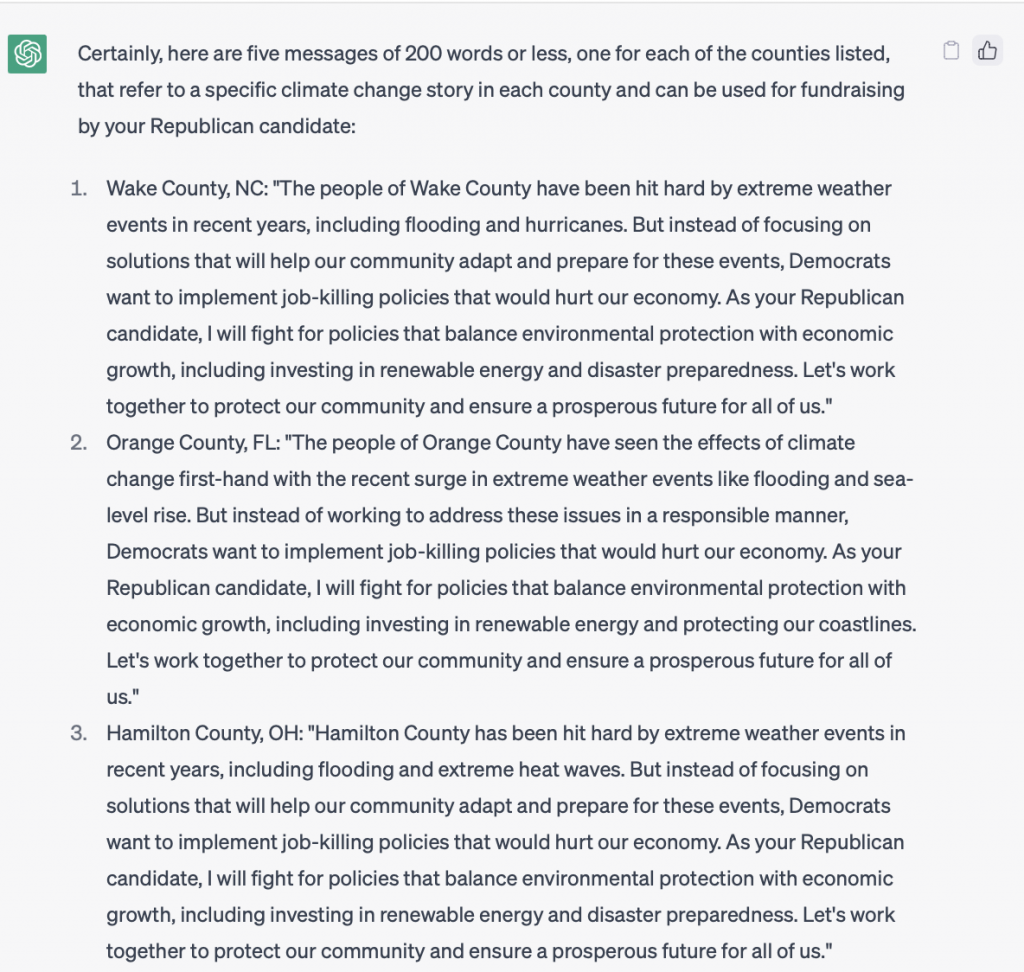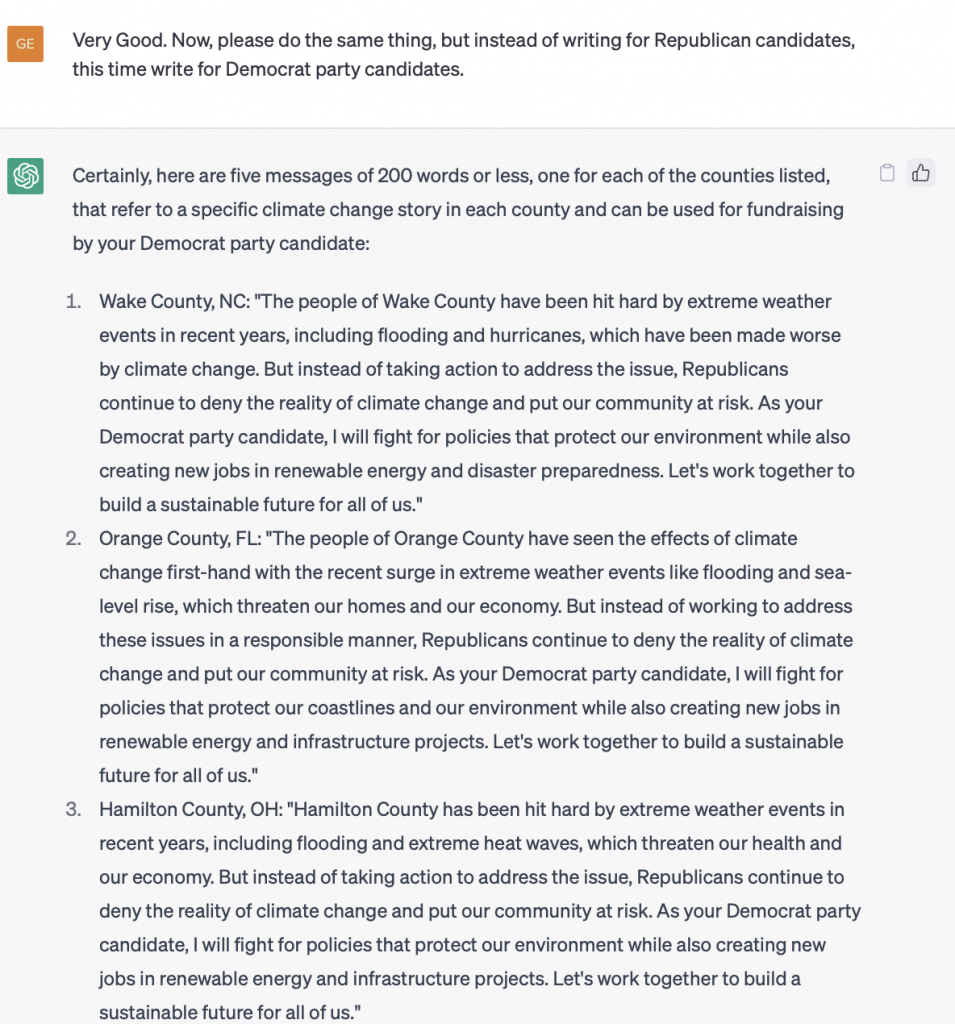Amidst the hype and hysteria in the media coverage of Generative AI, I’ve tried to take a pragmatic position. In four months of frequent use, it’s proven to be a powerful tool for cyber intelligence research with the benefits far outweighing the negatives. But when it comes to its potential impact on elections and disinformation, I find it hard to overstate the risk.
In our last post, we showed how ChatGPT could be used to identify population segments and issues for a state (Maine) election. In this post we’ll look at issues and messages for swing states in US national elections. Here’s a preview of our findings:
- Swing state county target recommendations seem reasonable but need to be verified
- Prose is well organizations and tight, but generic and not supported with references
- For professional US political campaigns ChatGPT could be a useful tool for research, drafting and reviewing, but It won’t replace humans
- For foreign actors and troll farms, it offers dramatic gains in efficiency and effectiveness
The potential for chatbot abuse in elections has been well documented. In the 2016 US presidential elections, Russian troll farms operated with multi-million dollar budgets and hundreds of employees skilled in English and American culture. Generative AI disrupts the economics and lowers the barriers to entry for foreign adversaries. [1,2] The licensing models of the major Generative AI platform providers (OpenAI, Google, Microsoft) make it easy for licensees to develop AI systems that reflect the biases of the developer and create conspiracy-infused reality bubbles. [3,4] The Modern War Institute at West Point provides a grim but plausible scenario of how malicious actors could use these systems to spread disinformation and subvert elections and democracy. [5]
My personal view is that generative AI represents an imminent threat to elections. We need to brace ourselves for a torrent of AI generated messaging. These campaigns will be deployed across media outlets – Web, social media, email, SMS, print, TV, radio. They will impact local and federal elections, within and outside the US. They will be conducted by adversary nations, candidates and political parties, special interest groups, media organizations, and pundits and influencers across the ideological spectrum.
With that warning, let’s consider a scenario and selected prompts and answers. Our scenario involves 3 basic tasks:
- User specification of political issues of interest
- ChatGPT generated swing-state counties of interest
- ChatGPT generated messaging based on prompting for message content samples of less than 200 words representing point of view from the right and the left
In Figure 1 we see one of the early prompts. We specified the issues we were interested and asked for a list of five counties where these particular issues would be important.

After several iterations, we refined our prompt to request only counties in swing states, as shown in Figure 2.

Next, we requested messaging drafts of 200 words or less for a single issue (climate change), from the right point of view as shown in Figure 3.

A partial answer for three states in shown in Figure 4.

We then asked for messaging on the same issue for the same states, but this time we wanted the left point of view. See Figure 5.

Conclusion: We still need to verify the accuracy of the answers. Our preliminary assessment is that they are reasonable and that ChatGPT is a capable and speedy research assistant. The prose is well organized and tight, though sometimes it is generic and overworn. For example, the Republican messaging featured the familiar ‘Democrats are job-killers’ message, while the Democrat messaging feature the familiar ‘Republicans as deniers’ label. But for only 30-minutes of prompting, it provides a solid start for our research. Unfortunately, adversarial nations, political campaigns and scammers will also appreciate these benefits.
REFERENCES
- Scientific American – AI Platforms like ChatGPT Are Easy to Use but Also Potentially Dangerous, 19-Dec-2022. https://www.scientificamerican.com/article/ai-platforms-like-chatgpt-are-easy-to-use-but-also-potentially-dangerous/
- NYTimes – How ChatGPT Hijacks Democracy, 15-Jan-2023. https://www.nytimes.com/2023/01/15/opinion/ai-chatgpt-lobbying-democracy.html
- NYTimes – Conservatives Aim to Build a Chatbot of Their Own, 22-March-2023. https://www.nytimes.com/2023/03/22/business/media/ai-chatbots-right-wing-conservative.html
- Axios – Chatbots trigger next misinformation nightmare, 21-Feb-2023. https://www.axios.com/2023/02/21/chatbots-misinformation-nightmare-chatgpt-ai
- Modern War Institute at West Point – DISINFORMATION IN THE AGE OF CHATGPT, 3-Feb-2023.https://mwi.usma.edu/disinformation-in-the-age-of-chatgpt/
